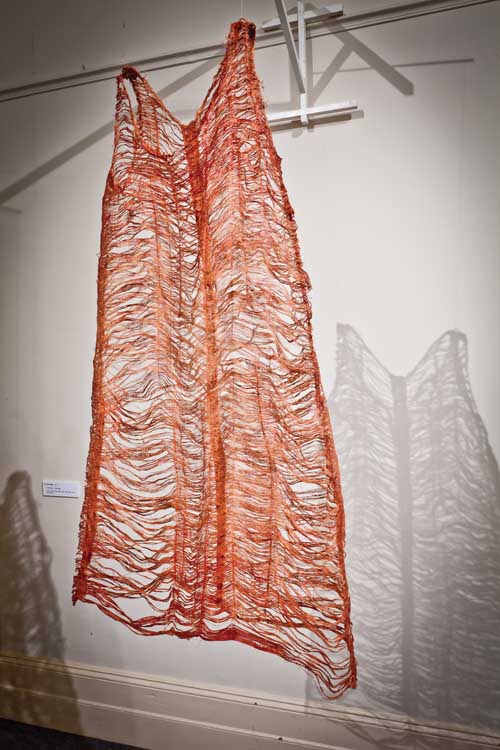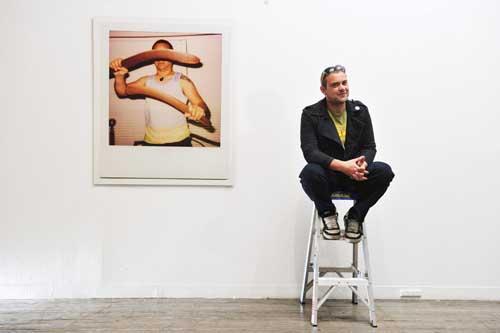
Part of this year's Perth International Arts Festival’s Great Southern program, Paperartzi, presented by New Arts Inc, is a biennial event now in its third season. Its conceptual focus is to investigate possibilities with paper in markmaking, and expanding on the previous two seasons, to consider markmaking as an entity in itself, as the catalogue states: "...to push the line off the page."
Artworks situated in shopfronts and in historic buildings, an art performance down a laneway, a dance performance, workshops and a forum were all a part of the occasion. Contributing artists were local, regional, from Perth and interstate. Also, in an organisational coup, the acclaimed South African artist, William Kentridge’s animated films were exhibited. Six of Kentridge’s Soho Eckstein works were loaned from the Art Gallery of WA.
Kentridge’s work was installed at the Vancouver Arts Centre, a gallery often jam-packed; frames and plinths shoulder to shoulder. For this exhibition however, in an insightful curatorial decision, the space was entirely given over to two ephemeral works.
Kentridge’s consummate animated films were projected high up, directly onto three of the gallery walls, with the projectors, sound speakers and comfortable discrete benches set in the centre of the room. The work demands the viewer spend time, so the seating is essential. As you settle in to watch, you notice the three simultaneous soundscapes fluctuate in and out - presenting a not unpleasant experience. Possibly not Kentridge’s intent, but nevertheless, because the sounds share dominance, the presentation worked well.
Located in an anteroom off the main gallery was Shadow Lines, Kati Thamo’s
subtle work of light and shadow. Both Thamo’s and Kentridge’s work contain similar elements, narrative drawing - one
still and one moving, and ephemerality - for each, turn off the light source and the work no longer exists.
As a counterpoint to Kentridge’s work, the stillness and quietness of Thamo’s piece was fitting. The single light source of the work frames two separate layers; transparent sheets suspended from the wall somehow casting a shadow of images onto sheets of paper behind them. Along with its engagement in the context of markmaking, the intrigue of the work is that on initial viewing the source of the image is not easily discernible.
A walk down York Street revealed a large part of the rest of what Paperartzi ’11 offered. Sue Codee’s stark white rendition of the personification of Albany’s two main peaks, Miss Melville and Mrs Clarence, was framed to its advantage by its dress shop window. A large incised paper cutout with a floating edge defined the pair. On their skirts, with marks left by deft wielding of a blade, the slopes that permeate the lives of those that live there are depicted.
Across the road in the Town Hall is another dress, this one not depicted but actual. Red Shift is a marri resin-drenched linen dress bereft of the vertical half of the weave of its cloth. With this work Holly Story presents further ideas of markmaking. She has extracted lines from the cloth, producing barely held together voids that present new lines of definition. Ann Copeman’s Echoes of a Truth scribble biro drawings on photographs of sonographs of pelvic bones that imply butterfly forms are strong imagery and the composition of Victoria Eyre’s Tearing at the Layers bears contemplation.
Further down the street, inside a coffee shop, is the work of Margaret Sanders. An artist visiting from South Australia, she is spending her days out at Torndirrup National Park that adjoins the southern edge of Albany. Her delicate suite of works on paper, titled Visiting Torndirrup and Sandwalk, are compiled progressively, inspired by her daily experiences in the coastal heath.
Down to the bottom of the street, and around the corner in the music shop window is Jillian Green’s Paper Chant. These small drawn works were a meditation on Gregorian chanting made manifest.
As you walked back up York Street you noticed the most poignant works on show in Paperartzi '11, ironically, by anonymous individuals. Displayed in shop windows on both sides were 600 contour line self-portraits by Albany school children. At their best, what was most engaging about them was that these self-portraits are a dichotomy; an act of seemingly egoless inquiry, a compelled mark searching for a face, redolent with humanity. It is because the artists are children that one is surprised, and for the same reason, not surprised after all.












